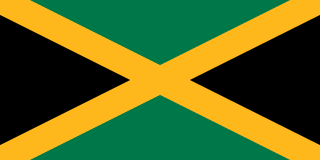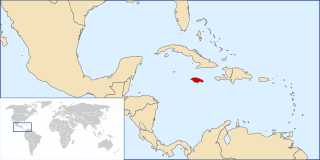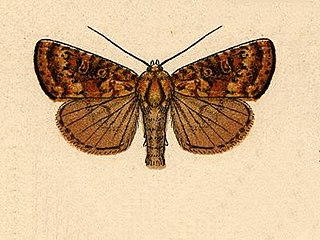
Jamaica is an island country situated in the Caribbean Sea. Spanning 10,990 square kilometres (4,240 sq mi) in area, it is the third-largest island of the Greater Antilles and the Caribbean. Jamaica lies about 145 kilometres (90 mi) south of Cuba, and 191 kilometres (119 mi) west of Hispaniola ; the British Overseas Territory of the Cayman Islands lies some 215 kilometres (134 mi) to the north-west.

The Arctiinae are a large and diverse subfamily of moths, with around 11,000 species found all over the world, including 6,000 neotropical species. This group includes the groups commonly known as tiger moths, which usually have bright colours, footmen, which are usually much drabber, lichen moths, and wasp moths. Many species have "hairy" caterpillars that are popularly known as woolly bears or woolly worms. The scientific name of this subfamily refers to this hairiness. Some species within the Arctiinae have the word tussock in their common name due to people misidentifying them as members of the Lymantriinae based on the characteristics of the larvae.

Phyllanthus is the largest genus in the flowering plant family Phyllanthaceae. Estimates of the number of species in this genus vary widely, from 750 to 1200. Phyllanthus has a remarkable diversity of growth forms including annual and perennial herbs, shrubs, climbers, floating aquatics, and pachycaulous succulents. Some have flattened leaflike stems called cladodes. It has a wide variety of floral morphologies and chromosome numbers and has one of the widest range of pollen types of any seed plant genus.

The erebid moth Ascalapha odorata, commonly known as the black witch, is a large bat-shaped, dark-colored nocturnal moth, ranging from the southern United States to Argentina. It is the largest noctuid in the continental United States. In the folklore of many Central American cultures, it is associated with death or misfortune.

The Dalceridae are a small family of zygaenoid moths with some 80 known species encompassing about one dozen genera mostly found in the Neotropical region with a few reaching the far south of the Nearctic region.

Urania sloanus, or Sloane's urania, was a species of moth of the family Uraniidae endemic to Jamaica. It was last reported in 1894 or 1895, but possibly survived until at least 1908. The species was first described by Pieter Cramer in 1779.

Several extinct species have been postulated, but owing to a lack of evidence they can only be regarded as hypothetical extinct species. They have caused confusion, as they may have been a separate species, a subspecies, an introduced species or a misidentification.
Evergestella is a genus of moths of the family Crambidae. It contains only one species, Evergestella evincalis, which is found in Florida, as well as on the Cayman Islands, Cuba, Puerto Rico and Jamaica.

Aellopos blaini is a moth of the family Sphingidae. It is found in Cuba, Jamaica, Hispaniola and Puerto Rico.

Heliothis lucilinea is a species of moth of the family Noctuidae. It is found on Hispaniola and Jamaica.
Lascoria alucitalis is a species of litter moth of the family Erebidae. It is found from Central America to the Guyanas, Cuba, Puerto Rico and Jamaica. It is also found in Florida.
Antiblemma rufinans, the live oak antiblemma, is a moth of the family Noctuidae. The species was first described by Achille Guenée in 1852. It is found in dry, sandy woodlands, barrens, and scrub forests of the southern Florida plain. It is also present in South America, Cuba and Jamaica.

Anthanassa frisia, the Cuban crescentspot, Cuban checkerspot or Cuban crescent, is a butterfly of the family Nymphalidae. Subspecies tulcis is known by the common names pale-banded crescent or Tulcis crescent; it is treated as a species by some authors. The nominate subspecies is found in the West Indies and southern Florida, with strays to northern Florida. Subspecies tulcis is found from Argentina north through Central America and Mexico to southern Texas, strays to west Texas and southern Arizona. Other subspecies are resident to South America.
Terastia meticulosalis, the erythrina twigborer or erythrina borer, is a moth of the family Crambidae. It has a wide distribution. In North America, it has been recorded from south-eastern Arizona, southern Texas, Louisiana and Florida. It is also present in Jamaica.
Salbia haemorrhoidalis, the lantana leaftier, is a moth of the family Crambidae. It is native to South America, Central America, the Antilles and the southern United States, but has been introduced in Hawaii in 1956, Queensland in 1958 and Réunion, Mauritius to control Lantana. The species was first described by Achille Guenée in 1854.
William Schaus was an American entomologist who became known for his major contribution to the knowledge and description of new species of the Neotropical Lepidoptera.
Jocara majuscula is a species of snout moth in the genus Jocara. It was described by Gottlieb August Wilhelm Herrich-Schäffer in 1871, and it is found in California, Florida, Central America, Cuba, Puerto Rico and Jamaica.
Eublemma recta, the straight-lined seed moth, is a moth of the family Erebidae. The species was first described by Achille Guenée in 1852. It is found in the United States from South Carolina to Florida and west to Texas. It is also found south to Argentina, on Cuba, Jamaica and Puerto Rico.

Perigea xanthioides, the red groundling moth or pied groundling moth, is a moth of the family Noctuidae. The species was first described by Achille Guenée in 1852. It is found from Canada to Brazil and on Jamaica. The wingspan is about 29 mm. The larvae feed on Vernonia and Eutrochium species.

Ptichodis herbarum, the common ptichodis moth, is a moth in the family Erebidae. It is found in the United States. It has also been recorded from Jamaica.












